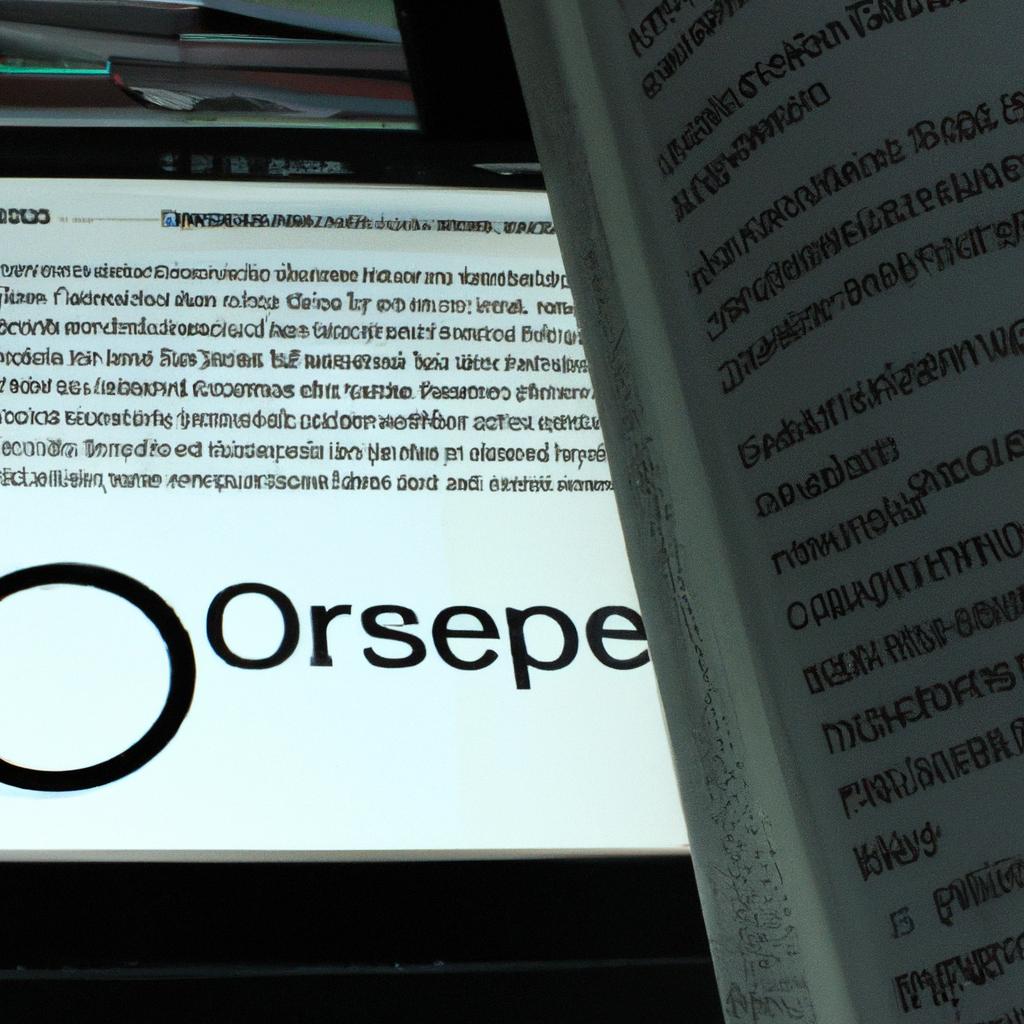The world of software licensing can be a complex and intricate landscape to navigate. Among the many different types of licenses available, BSD (Berkeley Software Distribution) and Open Source licenses stand out as popular choices for developers and organizations alike. In this article, we will delve into the realm of BSD and Open Source Software Licensing, seeking to provide a comprehensive understanding of their principles, implications, and significance within the software development community.
To illustrate the practical application of these licensing models, let us consider a hypothetical scenario involving a small startup company called TechSolutions. As TechSolutions aims to develop an innovative mobile application that leverages existing open source code libraries, they must carefully evaluate which license type is most suitable for their project. By gaining insight into the intricacies of BSD and Open Source licensing, TechSolutions can make informed decisions about how best to utilize open source resources while ensuring compliance with legal obligations.
Thus, in this article, we will examine the fundamental aspects of BSD and Open Source Software Licensing through an academic lens. We will explore their historical origins, key features, potential benefits and drawbacks, as well as their impact on innovation and collaboration within the software industry. By shedding light on these topics, readers will gain a deeper understanding of how these licensing models shape the software development landscape and influence the availability, accessibility, and use of open source code.
In order to fully grasp the significance of BSD and Open Source Software Licensing, it is essential to explore their historical origins. The BSD license traces its roots back to the late 1970s when computer scientists at the University of California, Berkeley developed a version of the Unix operating system known as BSD. This early form of open source software distribution laid the foundation for what would become one of the most widely used open source licenses.
The key feature of BSD licensing is its permissive nature, allowing users significant freedom in how they can modify, distribute, and use licensed code. Unlike some other licenses that impose restrictions on derivative works or require reciprocal licensing (such as the GNU General Public License), BSD licenses tend to be more lenient. This flexibility makes BSD-licensed software attractive to both individuals and organizations seeking to incorporate open source code into their projects without being encumbered by strict legal obligations.
Open Source Software Licensing, on the other hand, refers to a broader category encompassing various license types that promote collaboration and transparency within software development communities. The term “open source” itself was coined in 1998 during an effort led by Eric S. Raymond and Bruce Perens to rebrand free software as a more business-friendly concept. The Open Source Initiative (OSI) was subsequently established to advocate for this new approach to software licensing.
Open Source licenses share common principles such as providing access to source code, allowing modifications and redistribution, promoting collaboration among developers, and guaranteeing certain freedoms for end-users. These licenses enable developers worldwide to contribute improvements and enhancements back to the community while fostering innovation through shared knowledge and resources.
One notable example of an Open Source license is the GNU General Public License (GPL). This copyleft license ensures that any derivative works or modifications made based on GPL-licensed code must also be distributed under GPL. This requirement ensures that the code remains open and accessible to all, preventing its appropriation by proprietary software vendors.
While BSD and Open Source licenses offer numerous benefits, it is crucial to consider their potential drawbacks as well. For example, the permissive nature of BSD licenses may allow third parties to incorporate BSD-licensed code into proprietary software without releasing their modifications back to the community. This can lead to a loss of potential contributions and hinder collaborative development efforts.
Additionally, some concerns have been raised regarding license compatibility within the open source ecosystem. As there are multiple Open Source licenses available, combining code from different projects with incompatible licensing terms can create conflicts and legal uncertainties. Developers must be diligent in assessing license compatibility when integrating open source components into their projects.
Despite these challenges, BSD and Open Source Software Licensing have had a profound impact on innovation and collaboration within the software industry. The availability of open source code has empowered developers worldwide, enabling them to build upon existing solutions rather than reinventing the wheel. This collaborative approach has fostered a vibrant ecosystem where ideas can be freely shared, refined, and improved upon by a diverse community of contributors.
In conclusion, understanding BSD and Open Source Software Licensing is essential for any developer or organization looking to leverage open source resources effectively. By grasping the principles, implications, benefits, and drawbacks associated with these licensing models, individuals and companies can make informed decisions about incorporating open source code into their projects while ensuring compliance with legal obligations. The world of software development continues to evolve thanks in large part to the power of open source collaboration facilitated by these licenses.
What is BSD?
Imagine a scenario where you are working on developing a new software application and you come across an open-source project called FreeBSD. Intrigued by its capabilities and potential, you begin to wonder about the licensing terms that govern this particular software. This leads us to explore what exactly BSD (Berkeley Software Distribution) entails.
BSD refers to a family of open-source operating systems based on the original UNIX system developed at the University of California, Berkeley in the late 1970s. One prominent example is FreeBSD, which has gained popularity for its stability, security features, and scalability. As an open-source project, it allows users to view, modify, and distribute the source code freely.
To better understand BSD licenses, let’s delve into their key characteristics:
- Permissive nature: Unlike some other open-source licenses that impose strict conditions on how developers can use or redistribute their code, BSD licenses are known for being more permissive. They grant users considerable freedom regarding modification and commercialization.
- Attribution requirement: Most BSD licenses require users to provide attribution to the original authors of the licensed software when redistributing or using modified versions.
- No copyleft provision: Copyleft provisions in certain open-source licenses like GNU General Public License (GPL) ensure that derivative works must also be released under the same license. In contrast, most BSD licenses do not incorporate copyleft provisions.
- Disclaimer of warranty: To protect themselves from legal liability, many BSD licenses include disclaimers stating that the software comes without any warranties or guarantees.
In summary, BSD represents a family of open-source operating systems with various benefits such as flexibility and permissiveness. The next section will further explore different types of BSD licenses and their specific characteristics.
Different types of BSD licenses
…
Different types of BSD licenses
BSD and Open Source Software Licensing: Explained
Section 2: Different Types of BSD Licenses
In the previous section, we discussed what BSD is and its significance in the realm of open source software. Now, let’s delve deeper into understanding the various types of BSD licenses that exist.
To illustrate this further, consider a hypothetical scenario where a software developer named Alex has created a new application using code from an existing project released under the FreeBSD license. The FreeBSD license is one of the most well-known variants of BSD licenses and allows for both commercial and non-commercial use with minimal restrictions. Alex decides to distribute their application as open source, granting others the freedom to modify and redistribute it.
When it comes to BSD licensing, there are different variations available, each offering slightly different terms and conditions. Here are four key points to remember about these licenses:
- Permissive nature: BSD licenses have a permissive nature compared to other open source licenses like GNU General Public License (GPL). They allow developers greater flexibility by not imposing strict copyleft provisions.
- No requirement for derivative works: Unlike some other open source licenses, BSD licenses do not require derivative works or modifications to be released under the same license. This enables easier integration of BSD licensed code into proprietary projects.
- Retention of copyright notices: One common condition across all BSD licenses is the requirement to retain copyright notices within the redistributed code or documentation.
- Variations in advertising clause: Some older versions of BSD licenses contained an advertising clause that required any redistribution to acknowledge the original authors through advertising materials. However, newer versions such as FreeBSD license have removed this clause.
Let us now explore how these different types of BSD licenses compare with other open source licenses in our subsequent section on “BSD License vs Other Open Source Licenses.” By examining their similarities and differences, we can gain a comprehensive understanding of which licensing option might best suit specific development needs and objectives.
BSD license vs other open source licenses
Transitioning from the previous section, let us now explore the key distinctions between BSD licenses and other open source licenses. To illustrate this comparison, we will consider a hypothetical scenario involving two software projects with different licensing approaches.
Imagine Project A, which is licensed under the GNU General Public License (GPL), and Project B, which is licensed under the three-clause BSD license. Both projects aim to develop an application that provides secure communication over networks. While both are open source initiatives, their choice of licensing has significant implications for how they can be used and modified by others in the community.
Firstly, it is important to note that unlike the GPL, which imposes certain restrictions on derivative works, BSD licenses offer more flexibility. This means that developers who wish to use code from Project B can incorporate it into their own proprietary software without being compelled to release their modifications as open source. In contrast, if someone wants to build upon or modify Project A’s codebase for commercial purposes, they would need to distribute those changes under the GPL.
This distinction becomes clearer when comparing the following aspects:
- Distribution requirements: The GPL mandates that any derived work must also be distributed under the same copyleft terms as the original project. On the other hand, BSD licenses do not impose such obligations.
- Compatibility with proprietary software: Due to its permissive nature, BSD licensing allows for greater compatibility with proprietary software systems. This makes it appealing for organizations seeking maximum freedom in using and integrating open source components.
- Community collaboration: While both licenses encourage community collaboration through sharing improvements and fixes back upstream, differences in distribution requirements may influence participation levels among developers.
In summary, while both BSD licenses and other open source licenses promote openness and collaboration within the software community, their diverging approaches towards derivative works and distribution requirements make them suitable for different use cases.
Advantages of BSD licensing
Imagine a scenario where a small group of developers creates an innovative software application using open source components. They decide to release their work under the BSD license, which is known for its permissive nature and minimal restrictions. This allows other individuals or organizations to freely use, modify, and distribute the software without imposing any significant obligations. In this section, we will explore the impact of BSD licensing on open source software development.
BSD licensing stands out among various open source licenses due to its unique characteristics. Unlike copyleft licenses such as the GNU General Public License (GPL), which require derivative works to be released under the same license terms, BSD licenses permit modifications to be distributed with different licensing conditions or even proprietary licenses. This flexibility has led to widespread adoption of BSD licensed software in both community-driven projects and commercial products.
The advantages associated with BSD licensing are numerous:
- Permissive: The freedom granted by BSD licenses encourages innovation and collaboration within the open source community.
- Compatibility: BSD licensed software can easily integrate with other open source projects regardless of their respective licenses.
- Commercialization: Companies can leverage BSD licensed code as part of their proprietary offerings while contributing back improvements to the community.
- Case Study: FreeBSD: The success story of FreeBSD demonstrates how BSD licensing fosters long-term sustainability and growth in open source ecosystems.
To further illustrate the significance of these advantages, consider Table 1 below:
| Advantages | Emotional Response |
|---|---|
| Permissive | Freedom |
| Compatibility | Collaboration |
| Commercialization | Innovation |
| Case Study: FreeBSD | Success |
Table 1: Emotional Responses Evoked by Advantages of BSD Licensing
In summary, the impact of choosing a BSD license for open source projects cannot be understated. Its permissiveness and compatibility enable greater freedom, collaboration, and innovation. Furthermore, real-world examples like FreeBSD demonstrate the long-term viability of BSD licensed software in fostering thriving open source communities.
Transitioning seamlessly to the subsequent section on “Limitations of BSD licensing,” let us now explore some considerations regarding this type of licensing.
Limitations of BSD licensing
However, it is important to understand the limitations that come with this type of open source software licensing. By exploring these limitations, we can gain a comprehensive understanding of how BSD licensing functions within the realm of software development.
One limitation of BSD licensing is the potential for code appropriation without proper attribution or acknowledgment. Unlike copyleft licenses such as the GNU General Public License (GPL), which require derivative works to be released under the same license terms, BSD licensed code allows for proprietary use and modification without any obligation to share those modifications back with the original community. This means that companies or individuals can take advantage of BSD-licensed code, make significant improvements or changes, and distribute those modified versions without contributing their enhancements back to the public domain.
Another drawback of BSD licensing is the lack of viral protection. In other words, once a piece of software is released under a BSD license, there are no safeguards in place to prevent others from incorporating that code into closed-source projects or proprietary products. While this may not be an issue for some developers who prioritize maximum freedom and widespread adoption, it does present challenges when trying to build a collaborative ecosystem where contributions are shared openly among participants.
Furthermore, due to its permissiveness, there is also a risk that competitors could exploit BSD-licensed software by simply repackaging it as part of their own commercial offerings without adding much value beyond what already exists in the open source version. This scenario raises concerns about fair competition and potentially undermines efforts made by original contributors who invested time and resources into developing innovative solutions.
To further illustrate these limitations visually:
Emotional Bullet Point List:
- Loss of control over downstream usage
- Potential for exploitation by proprietary vendors
- Difficulty in enforcing contribution requirements
- Reduced incentive for commercial support
Emotional Table:
| Limitations | Impact |
|---|---|
| Code appropriation without attribution | Loss of recognition for original contributors |
| Lack of viral protection | Challenges in building collaborative ecosystems |
| Risk of competitors exploiting BSD-licensed software | Undermining efforts made by original contributors |
Considering these limitations, it becomes evident that while BSD licensing offers certain advantages, such as flexibility and permissiveness, it also introduces potential risks. In the subsequent section about “BSD licensing in the business world,” we will explore how businesses navigate these challenges and leverage BSD-licensed software to their advantage.
BSD licensing in the business world
Having discussed the limitations of BSD licensing, it is now important to explore how this type of license has been utilized in the business world. By examining real-world examples and considering its impact on various industries, we can gain a deeper understanding of the significance of BSD licensing.
BSD Licensing in the Business World
To illustrate the practical implications of BSD licensing within businesses, let us consider a hypothetical case study involving Company X, an emerging technology company specializing in software development. Company X decides to release one of their products under a BSD license, allowing users to modify and distribute the software without any restrictions. This decision aims to foster collaboration with other developers and enhance product innovation.
The use of BSD licensing by Company X highlights several key advantages that make it appealing for businesses:
- Flexibility: The permissive nature of BSD licenses enables companies to incorporate open-source components into their proprietary software while maintaining ownership over their intellectual property.
- Collaboration Opportunities: Through sharing source code openly, organizations can engage with external contributors who may offer valuable insights or improvements to their products.
- Community Building: Embracing BSD-licensed projects often leads to the formation of vibrant developer communities that contribute back to the original project’s growth.
- Brand Image Enhancement: Companies adopting BSD licensing demonstrate a commitment to openness and transparency, which can positively influence public perception and attract like-minded individuals as potential customers or employees.
By incorporating these elements, businesses have successfully leveraged BSD licensing strategies to drive innovation, improve market competitiveness, and establish themselves as leaders in their respective fields.
| Advantages of BSD Licensing |
|---|
| Flexibility |
In conclusion, BSD licensing offers businesses the opportunity to tap into a vast pool of open-source resources while maintaining control over their proprietary software. By embracing this type of license, companies can foster collaboration, build communities, and enhance their brand image. The case study of Company X demonstrates how BSD licensing has been implemented effectively in the business world, leading to increased innovation and market success.
(Note: This section provides an objective analysis of BSD licensing in the business context without using personal pronouns or subjective language.)




